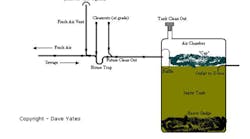Dave,
I live in the Atlanta area and operate a plumbing business there. A lot of the houses that I plumb are on septic tanks and occasionally we are having problems with a sewage smell. In most cases, it happens when we have had a good bit of rain. Everything is vented properly and we have done smoke tests on several of the houses. The only problem that I have found with any of the smoke tests was that one of the houses was letting the smell come back through the toilet. I would appreciate any advice or knowledge that you have on this subject.
Thank you,
John Holt
What a trip down memory lane that e-mail prompted! Naturally the first thoughts turn to closet gaskets and, more often than not, that a new gasket resolves the issue — but not always.
There was that half bath on a first floor with chronic sewer gas odors. After changing the wax gasket (which showed obvious signs of allowing water to escape over its top) with a sponge rubber gasket, the odors persisted.
Great, now it became our problem. Never mind this had been an ongoing problem since the day they’d moved in; we had set foot in the house and bought into the problem. Not only did the odor persist, the owners weren’t about to pay any bills unless we solved the mystery!
Fortunately, the next visit occurred on a cloudy, overcast and damp day. The atmospheric conditions created external pressure on the much lighter and drier air within the home and the odor was very pronounced within that small cubicle. The closer I got to the medicine cabinet, the stronger the odor. Removing it from the wall revealed what had gone awry: the installer had simply cut off the vent line where he needed to install the medicine cabinet! Re-routed and connected once again resolved the problem. We were paid.
Another septic tank odor issue in a second-floor cavernous master bathroom started out with replacement of the closet gasket. Once again, this did not solve the problem. This time, the odors would only occur occasionally. On a subsequent dash to be there when the septic odor was present, I sniffed around for the source with no luck and the smell had already dissipated.
The ceramic tiled walk-in shower doors were opened and no odor was present, so I dismissed that as a source. Fortunately, I left the doors open and as the closet was flushed I could clearly hear cascading water through the polished brass shower grate! A PVC ell could be clearly seen through the grate, but no water. No trap had been installed! No problem (or so I thought) to fix this situation; a simple access through the laundry room ceiling would get us to the ell.
Turned out that the second floor jutted out over a first-floor deck and that’s where the shower was located. With tongue-and-groove cedar siding installed over those surfaces, it was time to call in a carpenter. That was a very expensive shower drain trap!
But there have been other problems on septic tank systems that defied resolution. A friend who runs another plumbing firm called one day to express his frustration with repeated attempts at chasing a septic odor problem. He’d done everything possible: changed all the closet gaskets; checked for any missing traps; made sure all the lines were mechanically cleaned; had the tank pumped and checked the baffle for possible obstructions; he had installed anti-siphon traps at each sink location; and, as a last resort, he’d done a smoke test — with no results.
Although I strongly suspected a cracked or separated vent line, the owner ruled out any exploratory surgery through walls or ceilings.
So, what was missing from the septic system? The one thing we’re required to install on sanitary sewer lines connected to municipal systems: a trap set in the main line. We installed a standard 4-in. trap set consisting of a sanitary tee laid on its back, house trap and future cleanout (see drawing below) and voila — the problem disappeared!
The trap stops the septic tank odors dead in their tracks and the fresh air vent permits free passage of air by natural convection up and out through the roof vents, which carries away any foul odors within the home’s drainage system.
We’ve installed trap sets in no less than a dozen other septic systems over the years and always with the same resolution of a nagging odor problem. I had worried a bit about creating an air-bound situation initially, given that the tank is unvented, but what goes into a septic tank goes out the other side and its air volume doesn’t change sufficiently during that process to create any problems. That’s a win/win resolution and distinct improvement to the home’s venting system.
Dave Yates owns F.W. Behler Inc., a contracting company in York, Pa. He can be reached by phone at 717/843-4920 or by e-mail at [email protected].
All Dave Yates material on this website is protected by Copyright 2008. Any reuse of this material (print or electronic) must first have the expressed written permission of Dave Yates. Please contact via email at: [email protected]



